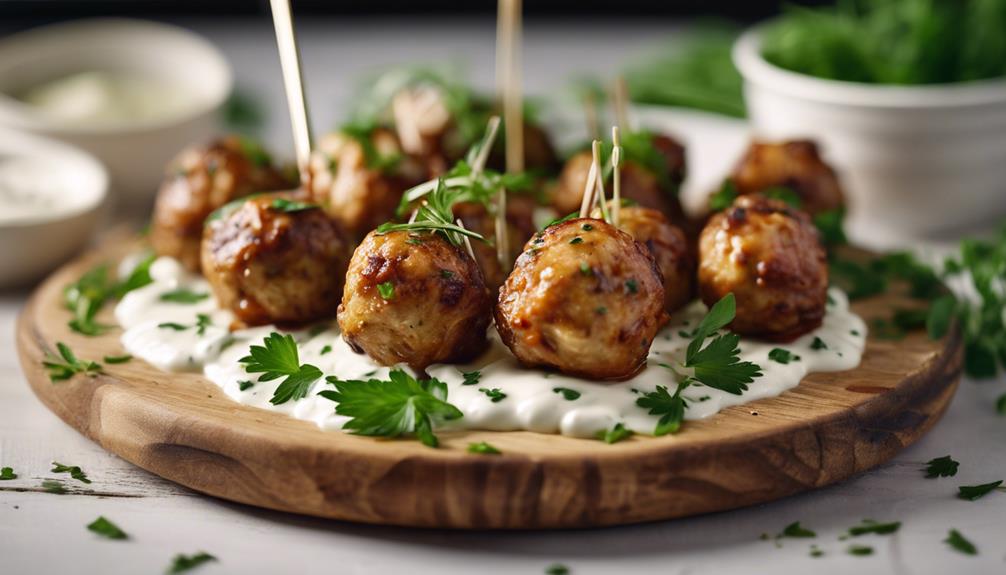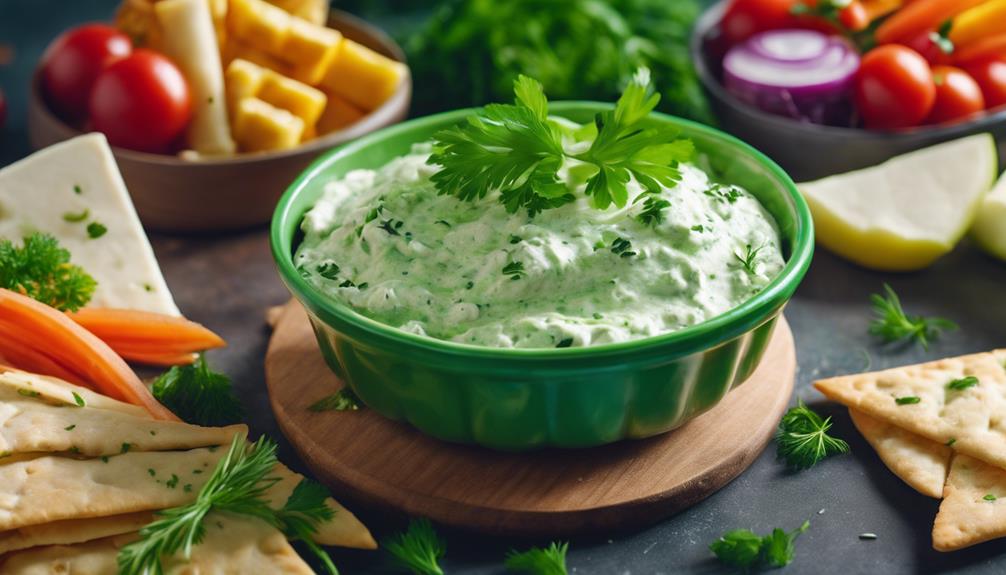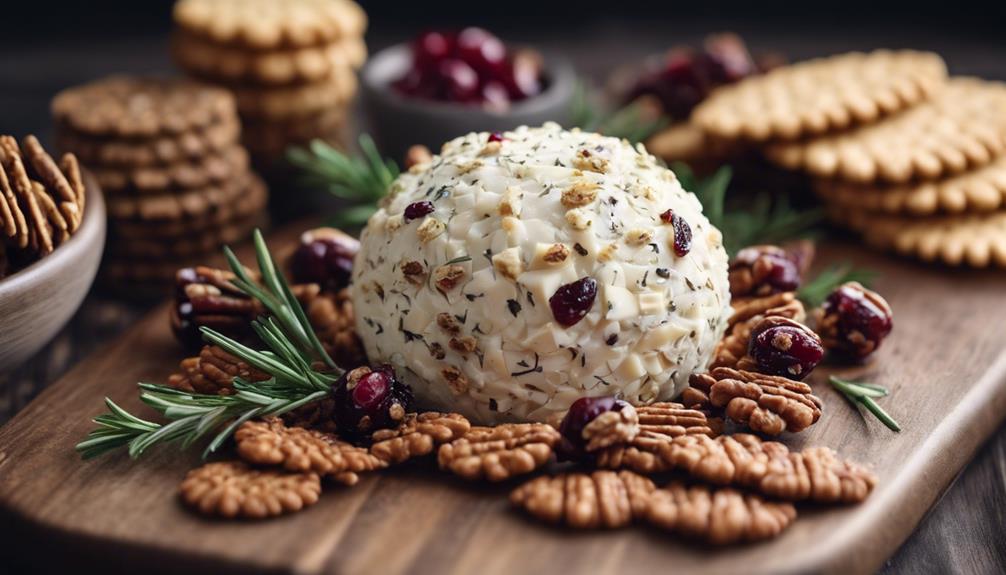Experience the robust flavors of a curried peanut dip, made with red curry paste, coconut milk, fish sauce, and peanut butter for a spicy and nutty appetizer. This combination provides plant-based proteins, antioxidants, and healthy fats, resulting in a well-rounded and delicious dish. To prepare, sauté red curry paste, simmer with coconut milk, and mix in peanut butter, vinegar, fish sauce, and honey. Adjust the spice levels by altering the amount of curry paste used. Use it as a dip for cucumber spears or as a dressing for salads. Get creative with serving options and store in the refrigerator for up to four days. Enjoy the blend of fiery spices and rich nuttiness.
Key Takeaways
- Harmonious blend of red curry paste, peanut butter, and coconut milk for a spicy and nutty flavor.
- Rich in plant-based protein, antioxidants, and healthy fats.
- Versatile dip for lettuce wraps, cucumber spears, salads, or rice noodles.
- Adjust spice levels easily with honey, curry paste, or cayenne pepper.
- Ideal make-ahead option with up to 4-day fridge storage for peak freshness.
Flavorful Ingredients for Curried Peanut Dip
What makes the curried peanut dip so flavorful? The secret lies in the harmonious combination of key ingredients such as peanut sauce, red curry paste, coconut milk, fish sauce, honey, and rice vinegar.
The rich and creamy texture of the dip is achieved through the blend of coconut milk and peanut butter, creating a luscious base that complements the bold flavors of the red curry paste and fish sauce. This unique fusion results in a dip that boasts a perfect balance of spicy, savory, and sweet notes, appealing to a wide range of taste preferences.
The incorporation of red curry paste brings a fiery kick to the dip, while the coconut milk adds a subtle sweetness that enhances the overall flavor profile. The fish sauce contributes a depth of umami flavor, further elevating the taste experience. Together, these ingredients work in harmony to create a decadent and satisfying appetizer that's sure to impress your guests.
Health Benefits of Spicy Peanut Dip

Spicy peanut dip offers a nutritious boost with its rich plant-based protein content from peanut butter. This flavorful dip combines the goodness of peanut butter, coconut milk, and red curry paste to create a tasty and healthful appetizer.
Here are some health benefits of enjoying this spicy peanut dip:
- Plant-Based Protein: Peanut butter is a great source of plant-based protein, essential for muscle repair and growth.
- Antioxidants: The red curry paste in the dip provides antioxidants that help protect your cells from damage caused by free radicals.
- Healthy Fats: Both coconut milk and peanut butter contribute healthy fats, which are important for brain function and overall well-being.
- Balanced Flavors: The dip offers a delicious blend of flavors without the need for added sugars or unhealthy fats.
- Nutrient-Rich Pairing: Enjoying the dip with fresh vegetables adds essential vitamins, minerals, and fiber to your snack, promoting overall health and wellness.
Step-by-Step Preparation Instructions

To prepare the curried peanut dip, start by heating vegetable oil and sautéing jarred red curry paste until fragrant. This process helps to release the flavors of the red curry paste, enhancing the overall taste of the dip.
Next, whisk in coconut milk and simmer the mixture until it's well combined. This step allows the flavors to meld together, creating a rich and creamy base for the peanut dip.
After that, remove the mixture from the heat and stir in creamy peanut butter, vinegar, fish sauce, and honey. These ingredients add depth and complexity to the dip, balancing the spiciness of the curry paste with the sweetness of the honey.
Don't forget to season the dip with salt to taste. Once seasoned, allow the dip to cool down before transferring it to a container and chilling it in the refrigerator. This chilling process helps the flavors to develop further, making it an ideal make-ahead appetizer that can be stored for up to four days in an airtight container.
Serving Suggestions and Pairings
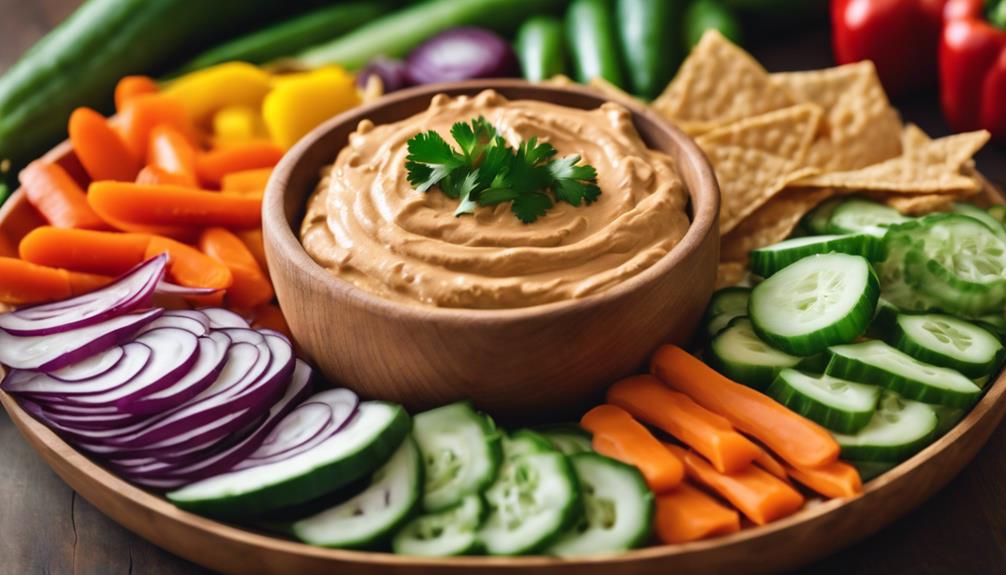
Consider how the curried peanut dip can elevate your dining experience with its versatile serving options and complementary pairings.
- Drizzle the peanut sauce over ground chicken lettuce wraps for a flavorful twist.
- Enjoy it as a delicious dip for Persian cucumber spears, adding a spicy and nutty element to the snack.
- Create a peanutty dressing by thinning out the dip, perfect for salads or rice noodles.
- Embrace the dip's versatility by exploring creative serving options, enhancing the overall dining experience.
- Its spicy-funky-salty-sweet balance makes it a versatile accompaniment for various dishes, appealing to a wide range of palates.
Experiment with different ways to utilize this flavorful dip to enhance your meals. Whether you prefer it as a dip for cucumber spears or as a dressing for rice noodles, the curried peanut dip offers a delightful combination of flavors that will surely impress your taste buds.
Tips for Adjusting Spice Levels

To adjust the spice level of your curried peanut dip, you can modify the amount of red curry paste used.
For those seeking more heat, consider adding extra curry paste or a pinch of cayenne pepper.
Conversely, if you prefer a milder taste, reduce the curry paste or balance it with a touch of coconut sugar or honey.
Spice Level Adjustment
Adjusting the spice level of the curried peanut dip can be easily achieved by tweaking the amount of red curry paste used. To customize the heat of your dip to your preference, consider the following tips:
- Increase the spiciness by incorporating chopped fresh chilies or a dash of cayenne pepper.
- Balance the heat with a touch of sweetness from honey or maple syrup.
- For a milder version, reduce the amount of curry paste and add more coconut milk or peanut butter.
- Taste the dip as you go and fine-tune the spice levels gradually to suit your palate.
- Experiment with small increments of ingredients to find the perfect balance between the heat from the curry paste and the creaminess from the peanut sauce.
Balancing Heat Levels
To achieve a well-balanced heat level in your curried peanut dip, experiment with adjusting the amount of red curry paste added to the recipe.
Red curry paste is the key ingredient that determines the spice levels of this spicy-sweet dip.
If you prefer a hotter dip, consider adding extra chili paste or red pepper flakes to intensify the heat.
Conversely, if you find the dip too spicy, balance it out by incorporating a touch of sweetness from honey or maple syrup.
For a milder version of the dip, reduce the quantity of curry paste and introduce more coconut milk or peanut butter into the mix.
Remember, adjusting the spice levels is a personal preference, so feel free to customize the heat intensity based on your liking.
Experimenting with different types of chili paste or hot sauces can also help you tailor the dip's spiciness to suit your taste buds perfectly.
Personalized Flavor Preferences
Experiment with the red curry paste quantity to customize the spice level of your curried peanut dip according to your flavor preferences. Adjusting the amount of red curry paste allows you to fine-tune the spiciness of the dip to suit your individual tastes.
Here are some tips for personalizing the flavors of your curried peanut dip:
- Increase the heat by incorporating extra chili paste or a sprinkle of cayenne pepper.
- For a milder flavor, reduce the amount of curry paste or balance it out with more coconut milk.
- Personalize the dip to suit your taste preferences by experimenting with different levels of spiciness.
- Tailor the dip to your liking by gradually adding spices and tasting as you go along to achieve the perfect balance of flavors.
Storage and Shelf Life Information

For peak freshness and flavor retention, store the curried peanut dip in a chilled, airtight container.
This dip, made with peanut butter and curry, can be prepared up to 4 days in advance. To guarantee its quality, it's essential to keep it chilled throughout, especially when using it for meal prep or snacking over the week.
The flavors of the dip only get better as they meld together when allowed to chill properly. By storing it in an airtight container, the dip's taste and texture will remain intact for several days. Remember that proper storage is key to maintaining the dip's quality.
Whether it's for a quick snack or part of your meal prep routine, keeping the curried peanut dip chilled and in an airtight container ensures that you can enjoy it at its best for days to come.
Creative Ways to Use Leftover Dip
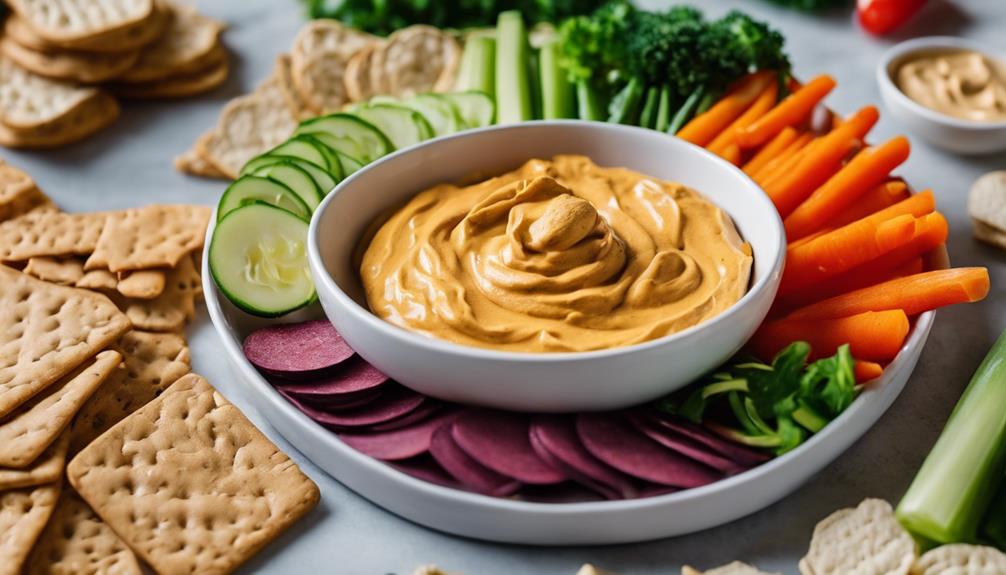
Leftover dip can be repurposed in various creative ways to elevate your meals. From using it as a spread for sandwiches to transforming it into a creamy salad dressing or a marinade for proteins, there are endless possibilities to explore.
Get inspired by these tasty dip transformations and dip-inspired recipes to make the most out of your leftovers.
Tasty Dip Transformations
Consider incorporating the extra curried peanut dip into various dishes to add a burst of flavor and creativity to your meals. Here are some innovative ways to transform your leftover dip:
- Spread it on sandwiches or wraps for a zesty kick.
- Mix it into cooked grains like quinoa or rice to enhance your side dish.
- Thin it out with water or broth to create a creamy salad dressing with a Thai peanut twist.
- Add it to stir-fries or noodle dishes for a pop of exotic flavor.
- Use it as a filling for baked stuffed bell peppers or mushrooms for a unique appetizer experience.
These simple yet creative transformations will make sure your leftover dip doesn't go to waste. By trying out these versatile ideas, you can turn a single dish into multiple culinary delights.
Dip-Inspired Recipes
To elevate your culinary creations and make the most out of your leftover curried peanut dip, explore these dip-inspired recipes that offer a blend of creativity and flavor.
Transform the dip into a flavorful sauce by mixing it with red curry sauce, curry paste, and fish sauce. This versatile sauce can be used to marinate grilled chicken or tofu, infusing them with a rich and spicy taste.
Alternatively, use the dip as a spread for sandwiches or wraps to add a delightful kick to your lunchtime meals. For a lighter option, thin out the dip with water or citrus juice to create a unique salad dressing that will tantalize your taste buds.
Additionally, consider mixing the dip with cooked noodles or rice for a quick and satisfying meal that's bursting with nutty flavors. You can also repurpose the dip into a marinade for vegetables or proteins before grilling or roasting them to perfection.
Embrace the versatility of your leftover peanut dip and experiment with these creative recipes to elevate your dining experience.
Feedback and Reviews From Users

Users have shared glowing reviews about the creamy, spicy-sweet Curried Peanut Dip, praising its versatility and delicious flavor profile. Here are some key points highlighted in their feedback:
- The blend of red curry paste, peanut butter, coconut milk, and fish sauce creates a harmonious flavor explosion.
- Its ability to complement a wide range of foods such as rotisserie chicken, jammy eggs, cucumber spears, and roasted sweet potatoes has been widely appreciated.
- Many users find it to be an ideal desk-friendly lunch option due to its perfect balance of spicy, funky, salty, and sweet notes.
- The quick and straightforward preparation process of the dip has made it a convenient go-to choice for various occasions.
- Overall, the rave reviews emphasize the well-rounded taste profile achieved through the combination of ingredients like red curry paste, fish sauce, peanut butter, coconut milk, honey, and rice vinegar.
Frequently Asked Questions
What Is Peanut Curry Made Of?
Peanut curry typically consists of key ingredients like peanut butter, red curry paste, coconut milk, and a blend of spices. You'll also find fish sauce, rice vinegar, honey, and vegetable oil to boost the flavors.
What Snacks to Dip in Peanut Butter?
For a tasty snack, dip vegetables like carrots and cucumbers or fruits like apples and bananas in peanut butter. Pretzels and crackers add crunch, while toast and bagels offer a heartier option. Granola bars and rice crispy treats are delicious dipped too.
Does Panang Curry Have Peanuts?
You know, Panang curry doesn't usually have peanuts. It's more about that creamy texture and subtle spice. But hey, if you're craving that nutty kick, maybe try out that Curried Peanut Dip!
Can I Substitute Elote Corn Dip for Curried Peanut Dip as an Appetizer Option?
Looking for a unique appetizer option? Consider substituting the curried peanut dip with a spicy elote corn dip recipe. This flavorful and creamy dip features all the delicious flavors of elote, making it a perfect option for a tasty and satisfying appetizer. Give it a try and impress your guests! Pair the elote corn dip recipe with crunchy tortilla chips or fresh vegetable sticks for an irresistible snack that’s sure to be a hit. The combination of smoky spices, tangy lime, and creamy cheese creates a bold and unforgettable flavor profile. Whether you’re hosting a backyard barbecue or a game day gathering, this elote corn dip recipe is guaranteed to steal the spotlight! Not only is this elote corn dip recipe easy to make, but it also offers a versatile serving option that can suit any occasion. You can even customize the heat level by adjusting the amount of chili powder or jalapeños to cater to your guests’ preferences. Once you serve this crowd-pleasing elote corn dip recipe, don’t be surprised if it’s the first dish to disappear from the table!
Conclusion
To sum up, the curried peanut dip offers a perfect blend of spiciness and nuttiness, making it a versatile appetizer for any occasion. With its unique flavor profile and health benefits, this dip is sure to impress your guests.
So, next time you're looking for a flavorful addition to your menu, give this spicy and nutty dip a try. As they say, 'variety is the spice of life,' and this dip certainly adds a flavorful twist to any meal.



